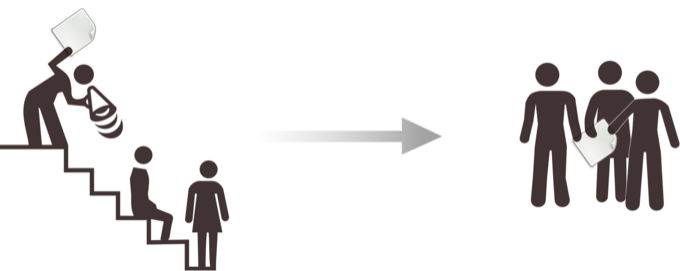Imagine this: You’re a low-level employee at an IT firm. Suddenly, one day, you get an email saying that the organization selected you as the CEO of the multinational firm for one day. What would you do?
Here’s another cherry to top it: You get an unlimited budget to implement and run one program of your choice. How will you utilize the company’s vast resources?
This feels like one of those memes or hypothetical situations that are fun to fantasize about. However, for Vincit, a Finnish company, it is a reality. Reports state that this initiative created and drove several meaningful changes to make the workplace better, including things like new co-worker lunches.
Using Perspective Swaps to Bring Changes
It seems so utopic and amazing that companies feel comfortable enough to implement such a program – typically called ‘perspective swap’ – at workplaces. However, it’s not always feasible as those companies scale.

A perspective swap happens when leaders step into another’s shoes to understand their unique challenges and problems. This opens up perspectives and opinions so that collaboration happens more.
While some argue that perspective swaps are also great for improving processes and structures within the team, my analysis and research did not find anything to corroborate that in real life.
Wrong Intentions Will be Statistically Higher, Creating Tokenism
Understanding that, statistically, evil intentions will exist is obvious. One of the biggest reasons the program wouldn’t work is when employee numbers increase, the chances that someone will sabotage or misuse the process will also increase
Even if someone wouldn’t try to actively sabotage the process, they could make things difficult for their co-workers in the teams they would have to go back to. Sure, you could argue that companies would have in place measures to limit the kind of power these employees would have. However, the moment you do that, you are reducing the entire initiative to mere tokenism.

If the initiative ends up being just a token, the intent doesn’t matter. Employees will only see it as an attempt to engage with them more in ways that won’t affect them positively. However, this engagement might not always end up being productive. In fact, employees might perceive this as a brazen attempt to appease them, taking the spotlight away from issues that really matter.
Degree of Competition Might Not Match the Perspective Swaps Initiative
The vast majority of employees might not even see the perspective swap program for what it is – a chance to do something better. More likely than not, after a few iterations, this program will just become a breeding ground for ambitious people looking to network or further their own agenda.
While it isn’t exactly a comparable example, consider Quora, Reddit, or Medium. They started off with noble purposes to disseminate knowledge and information. Today, they are just free and easy avenues for companies to market, while acting like individuals.
Almost every product-based company I worked with had Quora marketing and outreach programs.
While Quora still has its brand equity and credibility, it might not be long before perceptions change, the intent gets lost, and another platform emerges.
Unfortunately, companies can’t even weed these types of employees out. How will you know if someone is only doing this for networking or is genuinely passionate about making a difference? Lower levels can subvert any measures that the top management can conceive.
Eventually, it won’t be long before the top management stops paying as much attention to the program because the results just aren’t worth the effort they put in each time. Over time, the resources will dwindle, the approved projects will reduce, and the frequency with which this activity is conducted will change, making the whole endeavor pointless.
Competition from the Lower Levels
We discussed how employees could use the initiative to further individual agendas. However, we should also consider that they might lobby intensely to secure such a position. You have, say, 10000 employees, but only 1 can become ‘CEO for a day’.
Assuming this program happens once every quarter, that’s only 4 employees out of 10000. Those odds are worse than the conversion ratio at Harvard Business School. Naturally, employees would curry favors with their managers or those in charge of nominations.

When enough people vie for the same position and try to gain favors for the same activity, they would start giving ‘gifts’ to stand out for the favor. When you have the nominators used to receiving these ‘gifts’, you lose the whole point of the endeavor.
Besides, those employees vying for the positions at the top could use it for selfish gains too.
Perspective Swap From the Top to the Bottom
An HBR article discussing perspective swap states that perspective swaps are powerful tools for organizational change. That’s a great line to quote. However, just after that, comes the line,
“A perspective swap—where, for example, a CEO works as a customer service representative for a day, or an HR representative works in sales for a week—can help detox leaders from blind spots and distorted views of what’s actually happening on their teams.”
This sounds great in theory but is highly detached from reality because it just wouldn’t work out that way. What is to stop the employees from being on their best behaviors or acting as yes-men for the CEO on the day of their perspective swap?
This is like the principal’s ‘surprise visits’ at school. The teachers would be on their best behaviors and place students strategically to answer questions so that the principal thinks the teacher is performing well.
Managing Logistics
You might argue that management could make these visits could impromptu or maintaias a surprise. However, this statement assumes that everything will always be in place for the CEOs or top leaders to just assimilate into the service representative’s role.
In reality, just doing this requires a lot of arrangement and logistics management. As the famous adage goes, two people can keep a secret only if one of them is dead. If two people can’t manage it, how can multiple HRs, line managers, top leaders, and the board keep this a secret?
Limiting the Perspective Swap to the Top Management
The same HBR article gives the example of another San Francisco-based company that runs a simulation for the leaders to understand perspectives, with unexpected elements thrown into the simulation to provide depth to the simulation.
Notice how the example in the article went from the Finnish company’s employees enacting one employee-welfare activity to an American company where the perspective swap is limited to the senior management? And even for the senior management, there isn’t an actual perspective swap involved. It is merely a simulation.

The article also discussed “power poisoning”. That’s a valid phenomenon. But there’s one thing that even leaders who aren’t poisoned by power love: the status quo. Allowing lower-level employees to take the helm, even if for just a day, brings in countless uncertainties that the leaders might not be prepared to address.
So the solution? Either eliminate it or reduce it to the levels of management where the uncertainty is less. That, conveniently, happens to the senior and middle-senior management.
Is the End Goal Collaboration?
Going further to reinforce their statement, the article says that when two verticals were facing disjointedness and problems, the senior management swapped the heads of the teams, and things worked out.
From the research quoted in the article and the examples given, one thing becomes clear: the writers wanted to say that higher collaboration makes the organization frictionless. While it is possible to give glimpses into another department’s workings, the end goal is collaboration.
The leaders who’ve engaged in this perspective swap don’t go back to their teams and suddenly change everything there. No; all these examples mention how the ‘perspective swap’ has made two or more different teams work well together.
To me, that just sounds like a collaboration exercise.
Power Trip
When things don’t work well in an organization, you won’t have top leaders asking if they are the problem. They just end up blaming the department head for not meeting the quotas, who would, in turn, blame the managers, thus cascading all the way down to the lowest-level employees who would bear all the brunt.

Saying perspective swaps work because people realize there is more than one way to look at a situation seems to forget that people don’t want to look at the situation from a different angle. It forgets that people will work hard to ensure they are in the clear, making their quotas, and earning their bonuses.
Conclusion
Perspective swaps might sound good in theory but end up being too idealistic for real-world applications. Simulations, group exercises, and collaboration activities are great, but without reinforcements, they just act as 1-day retreats for the top leadership who just might view it as a waste of time.


This is highly informative!